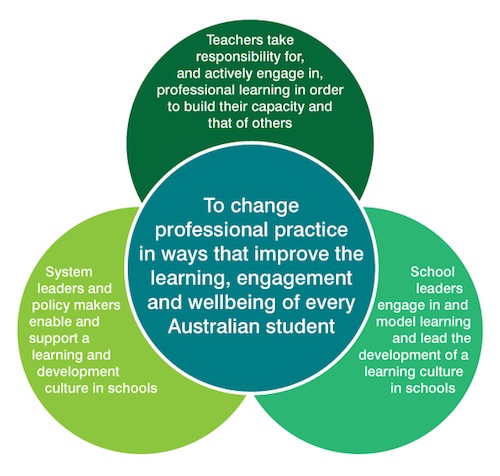The Asia priority in English and History
This introductory module builds teacher understanding of the Asia priority in the Australian Curriculum, outlines the organisational structure of English and History, and invites teachers to examine professional learning in terms of their teaching.
The module aims to:
- build teacher confidence in incorporating the Asia and Australia's engagement with Asia cross-curriculum priority in the teaching of English and History
- provide information on what, how and where Asia and Australia's engagement with Asia can be incorporated
- explore strategies and tools that assist teachers to lead or share in a curriculum change process in their schools to develop an Asia literate curriculum
- identify resources to support the development of Asia literacy
- provide opportunities for sharing and networking.
Intended outcomes of this professional learning module are for teachers to:
- develop awareness of how the Asia priority can be incorporated into the English and History curriculum
- identify entry points and opportunities for developing an Asia-literate curriculum in English and History
- understand what Asia literacy is in English and History
- reflect on how curriculum and pedagogical change can be manifested on the career continuum in the Australian professional standards for teachers.
Who can use this professional learning module?
The English–History professional learning module can be used by individual teachers or by teams of teachers.
There is substantial evidence to support that curriculum implementation and the process of professional learning are more effective and sustainable when teachers work together towards a common goal.

Dr Helen Timperley, in A background paper to inform the development of a national professional development framework for teachers and school leaders (AITSL), says:
In recent years the combined efforts of policy makers, school leaders, teachers and researchers have led to two inter-related developments. The first is a greater focus on how various professional activities affect the life chances of students in terms of their intellectual, spiritual, physical, moral, social and cultural wellbeing. It is no longer acceptable for professionals in schools to do their individual best. Rather, it is expected that they will engage collectively with what is known to be effective in improving outcomes for all students.
(MCEETYA, 2008)
Teachers accessing this professional learning programme may traverse the spectrum from being strongly Asia engaged to being not Asia engaged. As such, this programme provides entry points for a range of teachers in either the initiating, developing or consolidating stages of their own knowledge, skills and understanding about Asia in the subjects English and History.
What is a strongly engaged Asia literate teacher?
A strongly engaged Asia literate teacher has the following features. They:
- possess expert knowledge of content, assessment strategies and pedagogy for teaching Asia-related curriculum
- demonstrate familiarity with a wide range of Asia-related teaching resources
- actively build intercultural understanding
- frequently, purposefully and seamlessly integrate Asia into the curriculum
- use ICT to connect their students with students in Asia
- lead Asia-related learning within and beyond the school.
Read the Asia literacy and the Australian teaching workforce report (PDF 199 KB) for a fuller description.
Task 1: Organisational structure of the English modules
Two English modules have been written as springboards for further learning. There are various entry points into the modules, and they can be adapted, added to, developed and changed. The modules also serve as models for developing further Asia content in English.
The three interrelated strands in English: Language, Literature and Literacy as stated in the Content structure of the Australian Curriculum: English are used in the English modules.
- Read the sub-strands in the Australian Curriculum: English
- Go to the Years 9–10 English - Understanding China through literature module, Topic 1: The power of literature, a study of Balzac and the Little Chinese Seamstress by Dai Sijie and list the sub-strands that are focused on in this section of the module.
- Go to the Years 7–8 English - Stories that change lives module, Topic 5: Stories told by manga, cosplay and anime. What multimodal texts are used to develop language, literature and literacy skills and understandings?
Task 2: Organisational structure of the History modules
Two History modules use the inquiry approach and have been written as springboards for further learning. The modules can be adapted, added to, developed and changed. The modules also serve as models for developing other Asia content in History.
The History modules use Historical knowledge and understanding and Historical skills as stated in the Content structure of the Australian Curriculum: History.
Task 3: Organisational structure of the integrated English and History module
The organisational structure of the years 5 and 6 integrated module English and History uses English: Language, Literature and Literacy and Historical knowledge and understanding and Historical skills as stated in the content structure of the Australian Curriculum: English and History.
Task 4: Applying professional learning to teaching about Asia
Download and read the Australian charter for the professional learning of teachers and school leaders: a shared responsibility and commitment (PDF 256 KB).
The following questions are based on the statements in the charter. Reflect on these questions in terms of your teaching about Asia in your subject area.
- Read page 2 of the charter and describe one or more professional learning activities you have undertaken that led to sustainable change in your classroom in teaching about Asia.
- Explore this statement in the context of your teaching in relation to teaching about Asia: Collective responsibility and collaboration improves professional practice.
- In reference to page 3 of the charter, how do you, your faculty or school consciously improve practice in teaching about Asia?